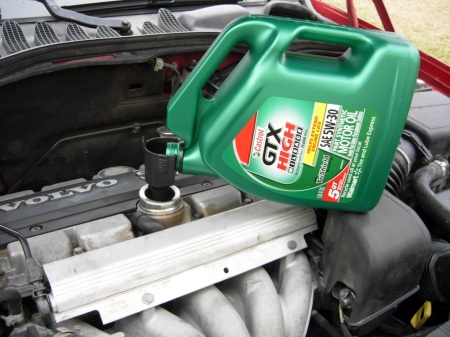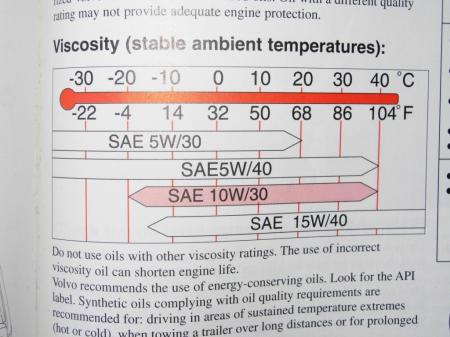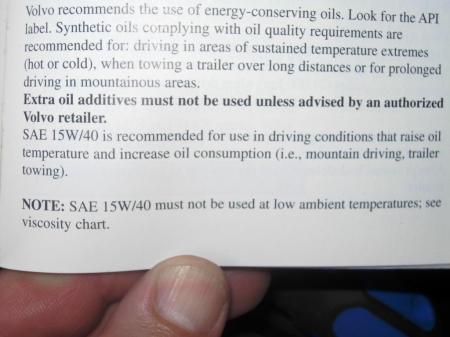Nothing will get a forum stirred up like a discussion of engine oil. Lots of opinions on the topic, and many people strongly believe in certain types, brands and viscosities.
Regarding brand or type, I have no strong opinion and to split the difference between the synthetic oil vs. conventional oil crowds I went with a blend of the two at the posted oil change topic, and selected a name brand based on price and availability. When not changing the oil myself I usually have it done at Firestone where they use their own conventional/synthetic blend.
Since then I have been mystified at the significant oil consumption of this car along with my daily driver, another 1997 Volvo 850 (sedan). Decent power and no tailpipe smoking but they seem to lose a quart every 1000 miles or less.
Pondering this I started researching oil consumption and type and realized that the 5W-30 is a bad choice for the 850 in this climate. Central Texas is relatively hot most of the year and rarely drops below freezing in winter. 5W-30 is intended for cold climates where normal oil will thicken at low temperatures. Here is a chart from the 1997 Volvo 850 owner’s manual:
It shows that the 5W-30 is fine for low temps (not needed here) but, worse, it is not recommended when used above 68°F (20°C) ambient, which we frequently exceed here. The problem with the low temp rating in higher ambient conditions is that the chemicals needed to make the oil flow when cold break down and form sludge. And as it breaks down there is less chemical to keep it thin at lower temps, so the cold rating becomes progressively weaker.
10W-30 would be a better choice, being commonly available, but even that is challenged by our high summer temps per the chart. 15W-40 seems ideal for my situation, based on min and max temperatures here. It’s not very common (more of a diesel engine oil) but I can find it at Walmart and auto parts stores plus at least one of the oil change places says they have it.
15W-40 is actually on the chart of permitted viscosities but there is a note in the manual cautioning the low end temperature range:
Not a problem here so I will be switching over to 15W-40 shortly and see if oil consumption drops off. Will add an update here as I learn if it helps or makes no difference in consumption.
Edit 29 September 2013: After switching to 15W-40 on both 850s I can report favorable behavior results. It’s been more than a month and oil consumption has dropped significantly. No smoke from the exhaust and the engine runs fine. Hardly notice the drop in oil level on the dipstick now where it was adding a quart every week or two before with thinner (5W-30) oil.
Tech Note
I’m no tribologist but I’ve done a bit of online research on this. Viscosity is a fluid’s resistance to flow. A single number (eg, SAE30) denotes oil viscosity at normal hot engine temperatures. The smaller the number the more quickly it flows, meaning it is thinner. Heavier oil flows more slowly and has a larger number. Ultimately you want a viscosity that is optimal for the car’s engine at operating temperatures, which is typically SAE 30 or 40 for the model 850.
A number with a W (for winter, such as 10W) means is behaves like a an SAE 10 rated oil at a low temperature. The lower the W number, the lower the temperature the oil will flow. So colder climates need lower W numbers when the engines are started up to have some lubrication until they warm up. These can be thought of as “thinner” oils until they get to engine operating temperatures when the second number becomes dominant.
The combination is called a multigrade oil and reveals the low temperature behavior and the normal high temperature behavior. So 5W-30 is a thinner 5 viscosity when cold but heavier 30 viscosity when warm.
In warm climates the low W numbers are too thin for old, worn engines so they get consumed faster than higher W numbers. I also expect that the older, worn engines can tolerate a higher warm viscosity as well, perhaps improving compression?
Some good references to viscosity I have found:
Motor Oil Viscosity Grades Explained in Layman’s Terms
What Does the Weight Mean on a Can of Oil?
More Than You Ever Wanted to Know About Motor Oil
How to Pick the Right Motor Oil


